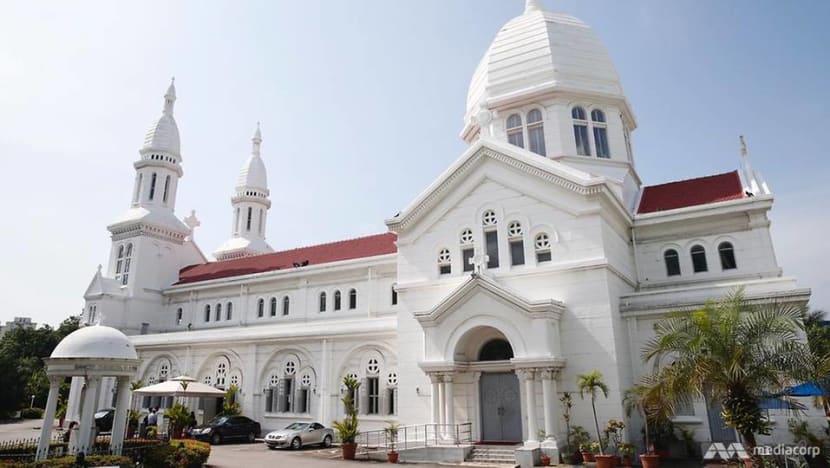7 things you probably didn’t know about Telok Blangah: Pirates, kings, and a healing spring

Going into the history of Telok Blangah. (Photos: Ang Hwee Min, Najeer Yusof/TODAY)
SINGAPORE: A new, free walking tour will focus on Telok Blangah's past and trace the 700-year maritime history of Singapore.
From the crown of Sang Nila Utama to the healing spring at the tomb of Radin Mas, to the Orang Lauts and sea pirates of Telok Blangah, the tour - organised by My Community - will look at the mystic charms and legends of the area. Starting from Saturday (Jul 20), the tour will run on the third weekend of every month.
Here are seven things you probably didn’t know about one of the most important neighbourhoods in Singapore’s history:
WHERE SANG NILA UTAMA THREW HIS CROWN INTO THE SEA
When Chinese merchant Wang Dayuan visited Singapore in the 1330s, he wrote in his travelogue about two settlements on the island.

The first, which Wang called Banzu, was at modern-day Fort Canning, and the other, known as Longyamen – or Dragon’s Tooth Gate – was in Telok Blangah.
The settlement in Telok Blangah was also recorded in the Malay Annals, which tell the story of the founder of Singapore, Sang Nila Utama. The story goes that Sang Nila Utama set out for the island of Temasek, and once off the coast of Telok Blangah, threw his crown into the sea to quell a fierce storm.
In Wang’s travelogue, he recorded finding a crown at Longyamen.
HOME TO THE ORANG LAUTS
The riverine and coast dwelling people – the Orang Laut – were navigators who grew different crops on the shore and sold them to passing ships.

In the 17th century, the Orang Laut forged alliances with the Malay rulers, the Temenggong. Serving in the naval forces, they ruled the seas off Telok Blangah.
One of the most prominent figures with Orang Laut ancestry is former Minister of Social Affairs Othman Wok. His great grandfather witnessed the signing of the treaty between the Temenggong and Raffles in 1819.
The Temenggong, who were royalty, were key figures in the establishment of the port of Singapore.
INFESTED WITH SEA PIRATES
Think pirates and most people would think of sea-faring Jack Sparrows. But the pirates of Telok Blangah lived on land.
In 1823, Raffles deprived the Temenggong of a share of Singapore’s revenues. With the royals struggling to pay those under their charge, the sea-faring community turned to piracy.
The Dutch Resident of Riau noted that the area had become “notorious with a great number of pirates who actually lived in New Harbour (Keppel Harbour) and Teluk Belanga districts of Singapore”.
THE POWER OF THE TEMENGGONG IN TELOK BLANGAH
It was in Singapore that Temenggong Daeng Ibrahim would go on to establish his economic power base, through the growth and collection of percha, a sap used to make latex.

Based in Telok Blangah, he was described as “one of the richest Malay chieftains in the Malay world” during his rule.
He leased the area to a shipping company, Peninsular and Orient, which developed coal sheds and wharfs. The company operated the earliest mail, cargo and passenger steamship in the region, with their service going as far as Ceylon and Calcutta, as they were known then.
Once the British moved into Singapore, he agreed to relocate and settled permanently in Johor.
KEPPEL HARBOUR'S FIRST "DEVELOPER"
Henry Keppel is often credited with the development of Keppel Harbour, but it was actually Temenggong Daeng Ibrahim who cleared the mangroves and swamps in the area to form the basis of the port.

The royals would also establish a series of kampongs from their base in Telok Blangah, including Kampong Ulu, Kampong Rocher, Kampong Bahru, Kampong Bukit Mawla, Kampong Radin Mas, Kampong Pantai Chermin and Kampong Heap Guan San.
THE SHRINE AND TOMB OF RADIN MAS
Radin Mas Ayu was a Javanese princess who was killed after shielding her father from being murdered, as legend goes.
Near her shrine at the foot of Mount Faber was a spring which was believed to have healing properties. When the spring became too popular and visitors started disturbing residents in the area, the water had to be piped underground and the spring filled in with cement.
The legend of Radin Mas goes: Pangeran Adipati Agung was the brother of a Javanese sultan. Well-loved by the people, he wed a dancer in secret because he could not marry a commoner.

Radin Mas Ayu was their daughter. When the sultan found out, he was furious and sent Pangeran to the front to deal with hostile invaders. While he was away, the king had Pangeran’s house burnt down.
The dancer died in the fire, but Radin Mas Ayu was rescued by a loyal servant. Pangeran found out and he severed ties with his brother. Together with his daughter, they settled in Telok Blangah as commoners.
Years later, after he defeated pirates threatening his new home, he was invited by the Singapore sultan to the palace, where he met a Javanese envoy, who reported back to the sultan.
The Javanese sultan arranged for Pangeran to marry a princess, and they had a son, named Tengku Chik.
One day, Tengku Chik accidentally cut his foot on a piece of broken plate dropped by Radin Mas. Her stepmother, jealous of how close Radin Mas was with her dad, accused her of deliberately harming the child.
Together with her stepmother’s nephew, Tengku Bagus, they plotted against Pangeran and Radin Mas. After intoxicating Pangeran and keeping him prisoner in a well, Tengku Bagus proposed to Radin Mas, threatening to kill her father if she did not agree.

At the wedding, Radin Mas was asked if her father had consented. Fearful for his life, she lied and said he had died, but her stepbrother, Tengku Chik, blurted out that he was kept prisoner in a well.
After Pangeran was rescued, Tengku Bagus was afraid for his life and lunged at Pangeran with a kris. Radin Mas jumped in front of her father, and was killed instead.
A SHELTER IN CONFLICT
Established in 1929, the Church of St Teresa in Telok Blangah is the only Catholic Church in Singapore featuring Romano-Byzantine architecture.

It catered largely to Hokkien-speaking Catholics when it first opened, and became a place of refuge for women who sought protection from Japanese soldiers during the occupation of Singapore in World War II.
Later, it sheltered many people during the riots in the 1950s, and again provided relief and living spaces for those made homeless by the Bukit Ho Swee fire of 1961, the biggest fire in Singapore’s history. About 16,000 people were made homeless after 2,800 homes were ravaged by the blaze.














